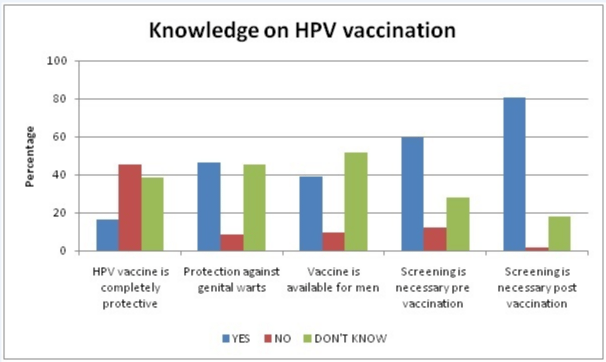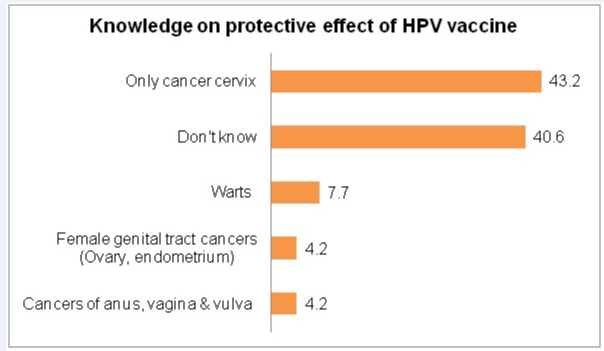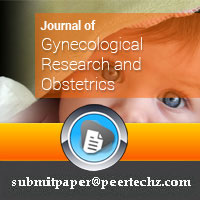Journal of Gynecological Research and Obstetrics
Human Papilloma Virus vaccine –awareness and acceptability amongst medical students in a tertiary teaching hospital in South India
Haritha Sagili1*, Swarup Kumar1, Subitha Lakshminarayanan2 and Papa Dasari3
2Department of P&SM, Assistant Professor, JIPMER, Pondicherry. India
3Department of Obstetrics and Gynaecology, Professor, JIPMER, Pondicherry. India
Cite this as
Haritha S, Kumar S, Lakshminarayanan S, Dasari P (2017) Human Papilloma Virus vaccine –awareness and acceptability amongst medical students in a tertiary teaching hospital in South India. J Gynecol Res Obstet 3(2): 025-028. DOI: 10.17352/jgro.000033Objectives: To evaluate awareness and acceptability of HPV vaccine amongst medical students in a tertiary teaching hospital.
Materials and methods: This was a cross sectional descriptive study carried out in a tertiary hospital in South India in January 2015. A self-administered questionnaire in English was given to 310 undergraduate medical students after obtaining consent. Parameters studied included awareness and acceptability of HPV vaccine. Data was analysed using SPSS 16 software.
Results: Response rate in this study was 100%.40% of students were <20 years of age, while the remaining were between 21-25 years, while gender distribution was equal (50%). 92% felt that HPV is preventable. 89% were aware of HPV vaccine and in 74% the source of information was medical books/classes. 81% knew of barrier contraceptive as method of HPV prevention. 54% thought that the vaccine is approved for the age group 10-20 years. 50% didn’t know that that the vaccine could be administered to males and 60% felt that screening for cervical cancer is necessary prior to vaccination. Need for cervical cancer screening post vaccination was supported by 80% of students. Approximately 50% of the students were not aware of the types, route, doses and 76% were not aware of the contraindications of HPV vaccine. 40% felt that it is protective only against cervical cancer and were unsure of the efficacy. 68% didn’t know the duration of protection and 78% had no idea about the cost. Overall 40% said that they would have the vaccine, 41% were not sure and 18% didn’t want to have the vaccine. 50% of the students felt that HPV vaccine should be incorporated in National Immunisation programme.
Conclusion: There is a lack of adequate knowledge regarding HPV prevention even among medical students. Health education and awareness campaigns on HPV prevention with more attention to the benefits of vaccination are necessary in order to improve acceptance of vaccination thereby preventing cervical cancer in future
Introduction
Cervical cancer is the second most common cancer among women worldwide in India. There are an estimated 132,000 new cases and 74,000 deaths each year [1]. Human papillomavirus (HPV) is responsible for virtually all cervical cancers. Vaccination against HPV as a method of primary prevention of cervical cancer is widely available in the developed countries. But in developing countries this is still a relatively new concept and education of health professionals plays an important role in the implementation of this strategy. Few studies [2–6], have addressed this issue and a recent study from India [7]. Showed that the most important obstacle in uptake of HPV vaccine was inadequate information and majority of medical students wanted to be educated by experts. The objective of this study is to assess awareness and acceptability of HPV vaccine amongst medical students in our hospital.
Material and Methods
This was a cross sectional descriptive study carried out in Jawaharlal Institute of Postgraduate Medical Education and Research, Puducherry,a tertiary care hospital in South India in January 2015. A self-administered questionnaire in English was given to 310 undergraduate medical students of the Institute. The questionnaire was designed to collect information on demographic variables, awareness regarding prevention of HPV, knowledge of HPV vaccine administration, perceived costs and efficacy of the vaccine, acceptability of the vaccine and source of information. Content validity for the tool was established by a panel of experts from Obstetrics and Community Medicine. Then it was pretested among a small group of interns. Based on feedback received from the experts and the pretest, the questionnaire was modified.
Before administering the questionnaire, informed consent was taken from all participants. The students were briefed for 15 minutes regarding the questionnaire. The study was approved by the Institute Scientific committee and Ethics Review board. The procedure followed was in accordance with the ethical standards of of the responsible committee on human experimenatation or with the Helsinki decalaration of 1975 as revised in 2000. Data was entered in MS Excel and analysed using SPSS 16 software. Data are expressed as percentages and figures.
Results
Response rate in this study was 100%. Among the study subjects, 40% were <20 years of age, while the remaining were between 21-25 years, while gender distribution was equal table 1.
Majority of the subjects (92%) felt that HPV is preventable. HPV vaccination (89%) and barrier contraceptives (81%) were the perceived modes of prevention of transmission of HPV infection among majority of the students. Half of the subjects felt that use of Oral Contraceptive pills (57%) does not offer protection from HPV and 47% were aware that antivirals drugs are not useful in HPV prevention. In three-fourths of the subjects (74%), the primary source of information regarding HPV vaccination was medical books and lecture classes. Media and friends were the other sources of information in 12% and 2% respectively.
Only 36% were aware of the types of HPV against which the vaccine conferred protection. Among the subjects, 45% were aware that HPV vaccination is not completely protective. Half of the subjects were not aware that the vaccine could be administered to males. Sixty percent felt that screening for cervical cancer is necessary prior to vaccination. Need for cervical cancer screening post vaccination was supported by 80% of students (Figure 1). Around 40% of the participants thought that HPV vaccine protects only against cancer cervix (Figure 2). Other benefits as stated by the subjects include Genital warts (7%), female genital tract cancers (4%) and other cancers (4%). One third of the subjects were aware of the specific HPV types protected by the vaccine.
Half of the subjects (54%) thought that the vaccine is approved for the age group 10-20 years. Approximately 50% of the students were not aware of the type of vaccine, number of vaccine subtypes, route, number of doses and booster requirements, while 76% were not aware of the contraindications of HPV vaccine table 2.
Half of the students were aware about the type of prevention offered through vaccination, while one third were not aware. Around 40% were unsure of the efficacy, while 68% were not aware of the duration of protection. Three-fourths of the students (78%) had no idea about the costs involved in vaccination table 3. Overall 40% said that they would have the vaccine, 41% were not sure and 18% didn’t want to have the vaccine. 50% of the students felt that HPV vaccine should be incorporated in National Immunisation programme.
Discussion
Human papilloma viruses (HPV) 16 and 18 are responsible for two thirds of all cervical cancers worldwide [8]. Condyloma acuminatum or genital warts, induced by HPV 6 and 11 are frequent among the young and difficult to manage. Because cancer of the cervix is the final consequence of chronic HPV infection, it can be prevented by vaccination. A prophylactic vaccine to protect against the benign [9]. Precancerous and cancerous lesions associated with HPV should save lives, reduce expensive diagnostic and therapeutic interventions, and have substantial individual and collective benefits [10]. The combination of HPV vaccination and cervical screening can provide the best protection against cervical cancer. It is important that as many people as possible get vaccinated. Not only does vaccination protect vaccinated individuals against infection by the HPV types targeted by the respective vaccine, but also vaccination of a significant proportion of the population can reduce the prevalence of the vaccine-targeted HPV types in the population, thereby providing some protection for individuals who are not vaccinated (a phenomenon called herd immunity).Despite the considerable success of early screening for prevention of cervical cancer, there has been insufficient awareness among the parents and health professionals regarding HPV vaccination.
92% of undergraduate medical students were aware that HPV was preventable. 25% of students didn’t know the age group recommended for administration of the vaccine. Half the students did not have knowledge regarding the types, dose, route, efficacy, protection and use in males. 75% were not aware of the cost and contraindications for the vaccine. Overall there was low level of knowledge regarding HPV vaccine amongst undergraduate medical students in our study similar to a study conducted in West India amongst female college students who also showed a low level of awareness of HPV vaccine [11]. In contrast, a better level of awareness of HPV vaccine was found among medical students in another premier medical school in South India [7]. As well as in a study in Malaysian medical and pharmacy students [4]. Another study conducted to find out awareness about the risk factors for cervical cancer among the educated youth in India, found the average awareness of cervix cancer to be 66% in India [12].
Awareness regarding the availability of vaccine against cervical cancer in our study was 89%; whereas in another cohort of medical students from South India it was 75.6% [7]. For our study population the most common source of information was medical school teaching followed by media and friends.
Only 41% of the students were willing to get vaccinated and none had been vaccinated. The major obstacles to implementation of HPV vaccine programs in our country include cost, acceptability, lack of public awareness and infrastructure, concern about unknown side-effects and social and religious barriers [13]. High cost of the vaccines was stated as the major concern for mass vaccination program in India [14]. Half of the students in our study opined that HPV vaccine should be included in the national immunisation programme.
Data in our study throws more light on the knowledge and attitude of medical professionals towards HPV prevention. Medical teaching on understanding of this important public health issue, with regards to etiology, of cervical cancer, availability of the vaccine and its protective efficacy should be emphasised not only to medical students buts also to other health care professionals like nursing and other paramedical students. Also educational campaigns for cervical cancer prevention should target women as recipients of health education.
Conclusion
There is a lack of adequate knowledge regarding HPV prevention even among medical students. Health education and awareness campaigns on HPV prevention with more attention to the benefits of vaccination are necessary in order to improve acceptance of vaccination thereby preventing cervical cancer in future. Education of health professionals plays an important role in the implementation of this strategy.
- Laikangbam P, Sengupta S, Bhattacharya P, Duttagupta C, Dhabali Singh T, et al. (2007) A comparative profile of the prevalence and age distribution of human papillomavirus type 16/18 infections among three states of India with focus on northeast India. Int J Gynecol Cancer of J Int Gynecol Cancer Soc 17: 107–117. Link: https://goo.gl/9iz9Ms
- Chelimo C, Wouldes TA (2009) Human papillomavirus knowledge and awareness among undergraduates in healthcare training in New Zealand. N Z Med J 122: 33–45. Link: https://goo.gl/bejY9b
- De Carvalho NS, Teixeira LM, Pradel EM, Gabardo J, Joly C, et al. (2009) Vaccinating against HPV: physicians’ and medical students’ point of view. Vaccine 27: 2637–2640. Link: https://goo.gl/HWQbyM
- Rashwan HH, Saat NZNM, Abd Manan DN (2012) Knowledge, attitude and practice of malaysian medical and pharmacy students towards human papillomavirus vaccination. Asian Pac J Cancer Prev APJCP 13: 2279–2283. Link: https://goo.gl/hZjUjN
- Chan ZCY, Chan TS, Lam YM, Lau LM, Li KK, Tam WH. (2009) HPV vaccination in Hong Kong: implications for medical education. Asian Pac J Cancer Prev APJCP 12: 1095–1099. Link: https://goo.gl/eJN6Dj
- Krupp K, Marlow LAV, Kielmann K, Doddaiah N, Mysore S, et al. (2010) Factors associated with intention-to-recommend human papillomavirus vaccination among physicians in Mysore, India. J Adolesc Health of Publ Soc Adolesc Med 46: 379–384. Link: https://goo.gl/Mi7YUL
- Pandey D, Vanya V, Bhagat S, Vs B, Shetty J (2012) Awareness and attitude towards human papillomavirus (HPV) vaccine among medical students in a premier medical school in India. PloS One. Link: https://goo.gl/i7AVBf
- Walboomers JM, Jacobs MV, Manos MM, Bosch FX, Kummer JA, et al. (1999) Human papillomavirus is a necessary cause of invasive cervical cancer worldwide. J Pathol 189: 12–19. Link: https://goo.gl/PHzQOK
- Sandø N, Kofoed K, Zachariae C, Fouchard J. A Reduced National Incidence of Anogenital Warts in Young Danish Men and Women after Introduction of a National Quadrivalent Human Papillomavirus Vaccination Programme for Young Women - An Ecological Study. Acta Derm Venereol 94: 288-292. Link: https://goo.gl/0yzDB3
- Hariri S, Markowitz LE, Dunne EF, Unger ER (2013) Population Impact of HPV Vaccines: Summary of Early Evidence. J Adolesc Health Of Publ Soc Adolesc Med 53: 679–682. Link: https://goo.gl/XfDQtO
- Saha A, Nag Chaudhury A, Bhowmik P, Chatterjee R (2010) Awareness ofCervical Cancer Among Female Students of Premier Colleges in Kolkata, India.Asian Pacific Journal of Cancer Prevention 11: 1085–1090. Link: https://goo.gl/p4SqDf
- Teresa J, Brijesh S, Chacchu B, Jenny C (2011) Awareness of Cervix CancerRisk Factors in Educated Youth: A Cross-Sectional, Questionnaire Based Surveyin India, Nepal, and Sri Lanka. Asian Pacific J Cancer Prev 12: 1707–1712. Link: https://goo.gl/euzt69
- Neerja B, Elizabeth J (2009) Cervical cancer prevention & the role of humanpapillomavirus vaccines in India. Indian J Med Res 130: 334–340. Link: https://goo.gl/bC0Wjd
- Mausumi B, Showket H, Vilas N, Bhudev CD (2009) HPV & HPV vaccination:Issues in developing countries. Indian J Med Res 130: 327–333. Link: https://goo.gl/yiSB9q
Article Alerts
Subscribe to our articles alerts and stay tuned.
 This work is licensed under a Creative Commons Attribution 4.0 International License.
This work is licensed under a Creative Commons Attribution 4.0 International License.



 Save to Mendeley
Save to Mendeley
